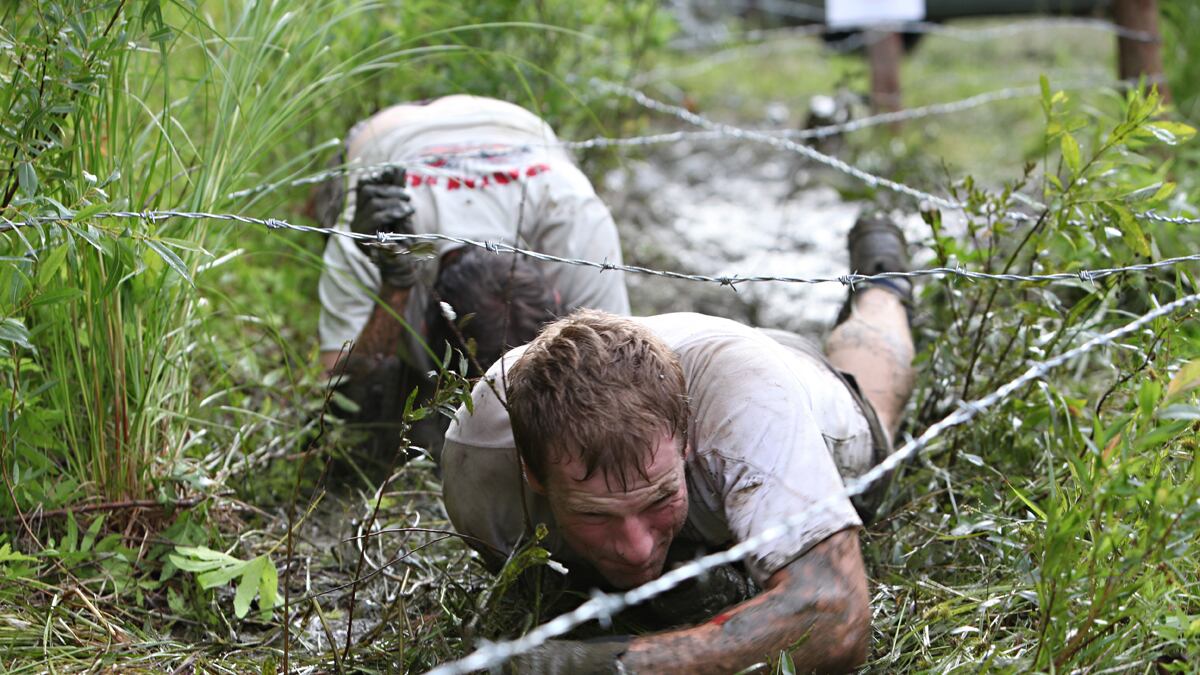This weekend nearly 200 people will journey to rural Pittsfield, Vermont, where they will enthusiastically submit to a series of tasks and ordeals that most people would find brutal and torturous, if not downright insane.
These men and women could be told to cut a tree stump from the ground, then lug it through muddy trenches covered in barbed wire and up a hiking trail. Or they might be ordered to run up a steep 2,000-foot mountain, memorize a list of American presidents, and run back down to recite the list, knowing that failure means another trip back to the top. Or they might have to eat pound after pound of raw onions. And not only will they have to endure all those chores—or their equivalent, for the race’s challenges are new each year. They’ll do it in a competition that could stretch on for 24, 48, or even 72 hours, with no set finish line and no idea of what might be coming next. And they’ll do it all with the race’s creators taunting them, telling them they don’t have what it takes to stick it out.
Welcome to the sixth-annual Spartan Death Race.
There are plenty of grueling races that test the limits of human strength and endurance, such as ultramarathons through Death Valley or the Himalayas, but the Spartan Death Race ups the ante by playing with your mind… endlessly.

One year, each competitor had to tote around not only a tree stump but also a bicycle frame for hours. Upon reaching a pond, the contestant was told to remove the bike chain. An official put the chain in a plastic bag and heaved it into the cold water. The racer had to dive into the water, retrieve the chain, assemble the bike, and then ride a distance of no more than a few hundred yards before the bicycle was declared extraneous.
“We test the entire mind and body in every direction, and then when you think you got it right, you find out we lied to you,” says race founder Joe Desena with a certain sadistic glee. “Life works that way.”
The race’s website warns potential candidates to sign up only “if you have lived a full life to date.” Next come the requirements—this year, each participant must show up at the starting line with a list of items ranging from goggles and a hand drill to a #2 Dixon-Ticonderoga pencil and a live fish.
The race can even begin earlier than the official start time of 4 a.m. Saturday. Last year, competitors were suddenly told on Friday that they had to work in teams of eight to lug a 500-pound bridge over several hills. Each year also has a theme that reveals itself in varying ways—last year’s theme was money: Contestants had to carry 50 dollars in pennies, which is 28 pounds, so they’d “really start think money is a burden,” Desena says. This year’s theme is religion.
The race is not the product of some hermetic mountain man’s fevered dreams. Desena, 42, is a native of New York City, where he grew up in Howard Beach, Queens, when the neighborhood was the domain of Mafia don John Gotti. It was the survival lessons of that tough neighborhood—where he was “stuffed into a phone booth, beaten with a baseball bat, handcuffed, and chased across the Belt Parkway”—that yielded the imagination necessary to create the Death Race. (Desena has help conjuring these Herculean labors from race director Andy Weinberg and a half-dozen other extreme athletes.)
But Desena says it wasn’t just learning to overcome adversity that inspired him—“legal or illegal, everybody was working hard and always hustling. It was a very driven place,” he says of his old neighborhood. Accomplishing your goals was celebrated no matter what: “I remember hearing very positive discussions about the people who robbed an armored car.”
Desena, who became a Wall Street equities and derivatives trader and moved to Pittsfield in 2002, certainly doesn’t approve of the criminal element. But as a veteran of 30 Iron Man races, he looks back fondly on the relentless work ethic. “That’s where the Death Race comes from,” he says. “I’m so tired of mediocrity in the world. I think people should work hard no matter what they are doing, and I hope this race wakes people up.”
Lately the organization has expanded nationally, running smaller Spartan obstacle races around the country—from three to 12 miles—to “give people a taste” of the Death Race. Then there are the Peak Races in Vermont, which include a 500-mile foot race—which has a 198-hour limit—and a 151-mile bike race that includes 14,000 total feet of elevation gain. There’s even a winter Death Race, which is considered a tune-up for the main event.
And yes, Desena, a man in perpetual motion, ran the race one year to show he could finish what he’d started. Weinberg upped the challenge by decreeing that every section had a time element that year. “The ultimate battle in life is against time,” Desena acknowledges, but adds that this trick “pissed me off. My heart was pounding because I knew couldn’t get knocked out of my own race.”
Anthony Capone did get knocked out, twice, but he is back for more. Capone, who owns a restaurant in Brooklyn, competed two years ago even though he was sick and lasted eight hours. Last year he lasted 24½ hours before, he says, he had to leave to open his restaurant. This year he declares he’s prepared to spend up to five days to make sure he finishes, training by walking Brooklyn’s hilliest streets burdened with bags of bells or rocks, sprinting through the borough with a full pack, and jogging in a leaded vest. “This is like nothing I’ve ever seen before,” he says, comparing it to England’s “Tough Guy Competition,” which provides similar ordeals in cold weather but which ends in two hours or under. “This sucks but it sucks much longer.”
“You don’t know what’s around the corner, and when you get around the corner you’re not very happy,” says Joe Decker, 41, who won last year’s race in 28 hours. Decker runs extreme fitness boot camps for civilians in San Diego and bills himself as The World’s Fittest Man. He suffered a pulmonary edema during a Himalayan race and said a Death Valley ultramarathon “melted my shoes and my brain.” But the Death Race still left a mark on him, in part because “you don’t know where the finish line is” and in part because few things have ever bothered him as much as having to eat six straight “fist-sized onions,” especially after hours and hours on the trail. “It was repulsive.”
Lisa Madden, 38, a New York City architect who finished in 35 hours, hadn’t brought enough food and was grateful for the onions, especially since she was savvy enough to grill many of them during one challenge that involved an open fire. Having lived through last year’s ordeal, Madden is contemplating bringing a salmon to the starting line as her live fish, just in case they’re told to kill, cook, and eat it.
While many contestants have military backgrounds, Desena says small-business owners tend to fare better. “They have a start-from-scratch personality,” he says and must face constant but always changing adversity on their own. “The military is a very structured and very team-oriented place.”
Among the rookies this year are Owen Duff, from Spokane, Washington, a former explosive ordinance disposal technician (think Hurt Locker) who holds the world record for running a mile in an 80-pound bomb suit (9:22) and Michelle Roy, a 107-pound middle-school teacher from Framingham, New Hampshire, who finished second in the winter Death Race.
“These guys are sick and twisted and I love it,” says Roy, 41, who knows that some of the elite women athletes competing could bench press her. She is undeterred, promising that no matter what, she will finish. “I’m tenacious. The only way I wouldn’t [finish] is if they pulled me off,” she says.
Like many of the competitors, neither she nor Duff is concerned about winning, only with finishing. “I am very competitive but I don’t view this as a race,” Duff says. “The challenge is within myself.”
Duff is running to raise money and awareness for the Wounded EOD Warrior Foundation, and while the Spartans pride themselves on their toughness and lack of sentimentality, Weinberg quickly offered to donate Duff’s fee back to the foundation. Beyond that, however, the rookies get no special treatment—they will be taunted by race officials every step of the way. “They want you to get frustrated and quit,” says Madden, who had to drop and do 100 pushups just before the finish line. “But to finish in front of Andy and Joe is then really sweet. And afterward, it’s all smiles from them.”
“The ones who finish are Rocky Balboas in real life,” says Desena. “They show great character no matter what you throw at them. They inspire us.”






